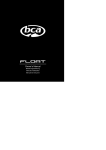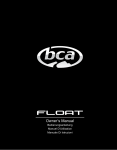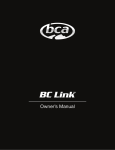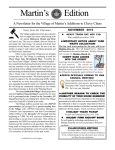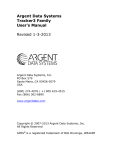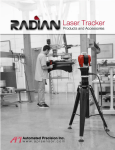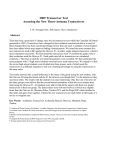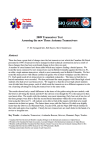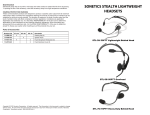Download ADVANCED USER MANUAL
Transcript
ADVANCED USER MANUAL This advanced manual describes the advanced functions of the Tracker3, including auto-revert, mute, software downloading, Signal Suppression, and Big Picture modes. The main emphasis is on solving complex multiple burials. No two avalanche rescue scenarios are the same. Throw in more than two buried victims–all close together–and a search can get complicated, requiring special searching techniques. While most beacons on the market come standard with multiple search functions such as “marking,” these are not 100% reliable, due to a phenomenon called “signal overlap” (see www.backcountryaccess.com/research). Therefore, it is important for rescuers to be well trained in more than one method for solving multiple burials. Through many years of field experience, BCA has determined that a searcher may need to utilize special multiple search techniques to rescue the victims. It’s important to note that most multiple burials can be approached as a series of single burials, solved either “in series” or “in parallel” using normal search mode. The only time multiple burials can become truly complex is when the victims are in close proximity (10-12 m) of each other. In general, we recommend using Signal Suppression for all scenarios involving only two victims. When more than two victims are buried, then special techniques might be necessary–especially if some of the victims are in close proximity. Remember: it’s fun to go out and practice multiple burial searching, and we encourage you to master it! But manpower, group organization, and excavation efficiency play equally important roles in real-life avalanche rescues. AUTO REVERT MODE Auto revert mode will make your Tracker3 automatically revert to TR (transmit) mode if the device does not move for one minute–or if there is movement, but the searcher remains in search mode for more than five minutes. An alarm will sound 30 seconds before the unit returns to transmit mode. This can be avoided by moving the device while in search mode or by pressing the Options button or moving the mode switch before the 30-second warning period has elapsed. Auto revert mode is activated by holding down the Options button while turning on the device, in either transmit or search mode. You must continue to hold down the Options button until “Ar” is shown on the display. Auto revert must be activated every time the unit is turned on. Otherwise, the unit can only be switched from search to transmit mode manually. MUTING THE SOUND The sound in Search mode can be muted by pressing the Options button while switching from transmit to search mode. “LO” text will appear in the display and normal sounds assisting search function are muted. 2 DOWNLOADING TRACKER3 SOFTWARE Using BCA software, you can update the Tracker3’s programming. Currently this is only possible with a PC (not Mac). To update: 1. Go to www.backcountryaccess.com/downloads; 2. Download BCA T3 software; 3. Install and start the program; 4. Connect the T3 to your computer with standard USB cable. LOW BATTERY WARNING When the battery power becomes too low to operate, the beacon will display the “Lb” sign. When you see this, replace the batteries before further use. When batteries are too low to do startup routines, a simple “0” will blink on the display. Mismatched batteries can act unpredictably at various temperatures, and low batteries can die unexpectedly fast. Therefore, we strongly recommend changing batteries once the battery power indicator reaches 40 percent. NOTE: never mix new and used batteries in your transceiver–or batteries of mixed brands. Never use lithium or rechargeable batteries. These may all lead to an inaccurate battery power indication. SIGNAL SUPPRESSION Signal Suppression mode suppresses the strongest signal and shows the searcher the second strongest signal, including directional arrows. Always stay in standard search mode when searching for the first transmitter. Once the first victim has been located and your fine search is complete, you are ready to use Signal Suppression. Signal Suppression mode is activated by pressing the Options button until “SS” is shown on the display. To enter suppression mode, the Options button must be released before “BP” is displayed. The multiple victim icon will flash while in SS mode. Suppression of the strongest signal will last for approximately one minute, giving the searcher time to move away from the suppressed signal and lock on to the next transmitter. The Tracker3 will automatically default from suppression mode to standard search mode after one minute. When this happens, the multiple victim icon will stop flashing and the Tracker3 will isolate the strongest signal. BIG PICTURE Big Picture mode is the closest thing to an analog beacon in the digital world. It displays distances and directions of all the beacons that are transmitting within range. With Big Picture mode, you can estimate how many beacons are in the search area along with their approximate direction. You can also perform a search in BP mode, but always remember to return to normal search mode during the fine search when you’re getting close to the victim. Big Picture mode is activated by holding down the Options button until “BP” flashes in the display. You must continue to hold down the Options button to stay in “BP” mode. Once the mode button is released, the T3 will automatically return to search mode. Like all Tracker3 functions, Big Picture is a real-time function, so it updates instantaneously if you are moving. ISOLATING MULTIPLE VICTIMS The following icons help to determine how many buried victims are within range of the rescuer: More than one signal within range. Two victims both within six meters of the searcher. More than two signals within range. More than two signals within range and at least two within six meters. 3 The following section highlights two multiple-burial search techniques that serious backcountry travelers and guides should know. THREE-CIRCLE METHOD: Most effective in large, flat areas This technique is used with your beacon in standard search mode. It is most effective in large, flat areas, as it will cover only a portion of the debris pile and sometimes requires walking uphill of the victim. Figure A Search (SE) mode In search mode (SE), only the strongest signal (beacon #1) is shown. Signals further away are received (beacon #2), but not shown in the distance and direction display. 2 MICRO-SEARCH STRIP METHOD: Most effective in complex multiple burials in a smaller search area This method allows a searcher to use a simple, systematic approach to solve a multiple burial. It works well in small scenarios (such as guiding exams) since it involves making many tight passes through the entire debris pile. It also works well in steep debris since it doesn’t require walking uphill. Based on the number of buried victims, you will determine how wide your search strips need to be (this is usually an estimate as you’re “thinking on the fly”). The width of your search strip will decrease as the number of victims increases. Like the three-circle method, this technique is used with your beacon in standard search mode. The searcher must rely heavily on the distance readings on the searching beacon, not so much the directional arrows. This is because it requires bracketing rather than following the flux lines. Figure C To perform this method, stay in SE mode and take three steps away from the first found victim. With your beacon on the snow surface, walk in a circle of this radius around the victim, attempting to acquire another signal in SE mode. If a new signal is acquired, begin bracketing until it has been pinpointed. If no other signal is acquired, take another three steps back and repeat up to a maximum of three circles (nine steps). If a new signal is acquired and pinpointed, and there are still more victims suspected to be in close proximity, then return to the point where you abandoned the circle search (in SE mode) and begin searching again from there. Figure B Three-Circle Method When using the threecircle method, walk around beacon #1 in concentric circles until you detect the signal of beacon #2. During the first circle, keep the searching beacon as close as possible to the snow surface. ȝm ȝm Micro Search Strips 3m A search strip width of 2-5 meters is common in guiding exams and other small scenarios. After pinpointing each victim, remember to return to the point where you left your search pattern. 3m 3m 1.5m 3m 3m 1.5m 3m 3m x x 3m Do not leave your micro-search strips and start bracketing until you see distance readings that are less than or equal to your search strip width (in this case, 3 meters). When this occurs, find the lowest distance reading and begin probing. Remember to search as close as possible to the snow surface. Always mark the point at which you departed from your search strips and return to that point to resume searching for the next signal. 4 Remember, these techniques all assume there is only one searcher available. With additional searchers you would spread out and search “in parallel” (see www. backcountryaccess.com/research). HOW TO PASS A GUIDING EXAM USING TRACKER3 After 20 years of beacon searching with the world’s top rescue personnel, we have found that strong beacon searchers rely on a multitude of techniques. A complex beacon search may require a searcher to act on the fly and improvise based on how the scenario unfolds, often combining two or three techniques. There are a few methods you should have ready to go (micro-search strips, three-circle method, Signal Suppression, Big Picture, etc.). Variables such as the number of victims, the distance between them, and the victim’s burial depth make it nearly impossible to advise one technique over another. The following hybrid technique is targeted directly at those striving to pass a guiding exam and for advanced users looking to round out their search skills. While no two exams are the same, they all share similar characteristics: • There is only one beacon searcher (yourself). • All transmitters are buried in an area of 100 m x 100 m or less. • You can usually count on two beacons within close proximity of each other and a third spaced 20 m or more away. • Out of the 3 beacons, 1-2 may be buried over 2 m deep. • Finally, in most guiding exams you’re not allowed to turn off transmitters once they’re found. If the scenario is small enough, don’t be afraid to begin micro-search strips, immediately. Otherwise, when you enter the search area, be sure not to move too far down the slope, as it’s always inefficient to travel back uphill. Sometimes one transmitter is intentionally tucked up high on the flanks and be easy to miss, especially if this transmitter has poor transmit strength or antenna orientation. Enter the search area and begin your signal search. If a signal is immediately received, but is greater than 20 m away, continue your signal search. Be sure to get within 20 m of each flank and cover the entire path. Do not abandon your signal search until you obtain a reading lower than 20 m. This will prevent you from missing a weak or poorly oriented transmitter. Once locked on to beacon #1, conduct the coarse and fine searches, and probe. Locate the first beacon and take a moment to gather additional information: If the multiple burial icon is illuminated, be prepared to use Signal Suppression or micro-search strips, especially if the close proximity brackets are also illuminated. Be prepared to use Big Picture to determine how many signals are close and/ or further away. Press the Options button to suppress beacon #1. After suppressing, T3 will then take you to beacon #2. Once you have found beacon #2 using Signal Suppression and have conducted your fine search, keep your T3 as close to beacon #2 as possible and use the suppress function again. Remember, T3 suppresses only one signal at a time. When you suppress a second signal, it will then show you the next closest signal–even if that beacon was suppressed earlier. If beacon #3 is closer to beacon #2 than beacon #1 (scenario A, below), suppression should take you to beacon #3 automatically. However, if beacon #1 is closer than beacon #3, (scenario B), T3 will bring you back to beacon #1. If this is the case, use Big Picture mode to find the general direction to the third signal. After moving closer to the third signal, release the Options button and T3 will automatically isolate that third signal. 5 While no two scenarios are the same, the above techniques will provide you with a solid framework to work through any complex scenario. Remember that beacon searching is the fast part. Most multiple burial rescues are limited by the number of shovelers available. However, special techniques may be beneficial if there are enough rescuers available for shoveling. Figure D Big Picture Mode T3 suppresses one signal at a time. If beacon #3 is further away from beacon #2 than #1 (scenario B), then use Big Picture mode to move toward #3. Scenario A #1 Scenario B #1 #2 These techniques are mainly used and directed toward professional guides and advanced beacon searchers. Shoveling is the ultimate crux in an avalanche rescue and the efficiency of your rescue will greatly depend on how many resources you have to dedicate toward excavation. Be sure to check out BCA’s video on the “ABC’s and D of Digging” at www.backcountryaccess.com/education. #2 #3 #3 Repeat the same procedures for the fourth signal as you did for the third, if necessary. Alternatively, simply use micro-search strips in normal search mode to cover the remaining debris. To learn more about advanced search techniques or to set up a “How to pass a guiding exam” training session, please contact [email protected]. Backcountry Access, Inc. Boulder, Colorado USA www.backcountryaccess.com







